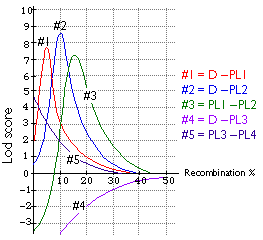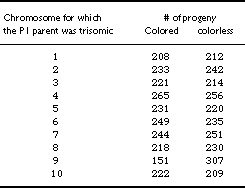| 4. |
Five recessive mutations on the right arm of the X chromosome of Drosophila cause stringy bristle (sg), lazy eyes (ly), tin body (tn), zillion eye (ze), and miniature wing (m) phenotypes. The genes for lazy eyes, tin body and zillion eyes are known to be located between the stringy bristle locus and the miniature wings locus, and tn is known to be closer to sg than to m, but the gene order of ly, tn and ze is not known.
Embryos were exposed to X-rays and then allowed to develop to adulthood; the males were mated separately with (non-irradiated) females showing all five recessive traits. [Call these the P1 matings.]
|
 Linkage analysis was done for a certain human disease gene with respect to polymorphic loci PL1, PL2, PL3, and PL4. Some of the resulting Lod scores are plotted. Each curve represents the lod score vs. recombination frequency distribution for a polymorphic site with respect to either the disease locus (D) or with respect to one of the other polymorphic sites. For example, Curve #1 shows the lod score vs. recombination frequency between the disease locus D and polymorphic site PL1.
Linkage analysis was done for a certain human disease gene with respect to polymorphic loci PL1, PL2, PL3, and PL4. Some of the resulting Lod scores are plotted. Each curve represents the lod score vs. recombination frequency distribution for a polymorphic site with respect to either the disease locus (D) or with respect to one of the other polymorphic sites. For example, Curve #1 shows the lod score vs. recombination frequency between the disease locus D and polymorphic site PL1. Look back the experiment of Harriet Creighton and Barbara McClintock to demonstrate that crossing over leads of recombination (p. 35 of your lecture notes). To do that experiment, they had to know which chromosome carried the colored and waxy endosperm traits. Here is a version of the experiment that identified the chromosome carrying the colored endosperm trait (again, R = colored endosperm, r = colorless). A homozygous RR strain was crossed to ten different strains (call these the "P1 parents"); each of these 10 strains was trisomic for a different chromosome and all were homozygous recessive for endosperm color. Trisomic progeny from each cross were picked out and crossed to disomic rr plants. The progeny obtained are shown on the right. Assume that trisomics in corn are viable (at least with one chromosome at a time being trisomic).
Look back the experiment of Harriet Creighton and Barbara McClintock to demonstrate that crossing over leads of recombination (p. 35 of your lecture notes). To do that experiment, they had to know which chromosome carried the colored and waxy endosperm traits. Here is a version of the experiment that identified the chromosome carrying the colored endosperm trait (again, R = colored endosperm, r = colorless). A homozygous RR strain was crossed to ten different strains (call these the "P1 parents"); each of these 10 strains was trisomic for a different chromosome and all were homozygous recessive for endosperm color. Trisomic progeny from each cross were picked out and crossed to disomic rr plants. The progeny obtained are shown on the right. Assume that trisomics in corn are viable (at least with one chromosome at a time being trisomic).